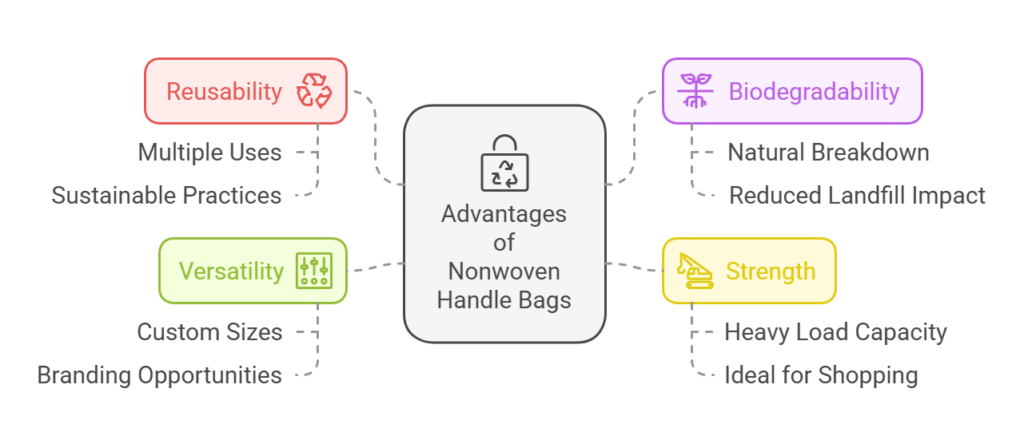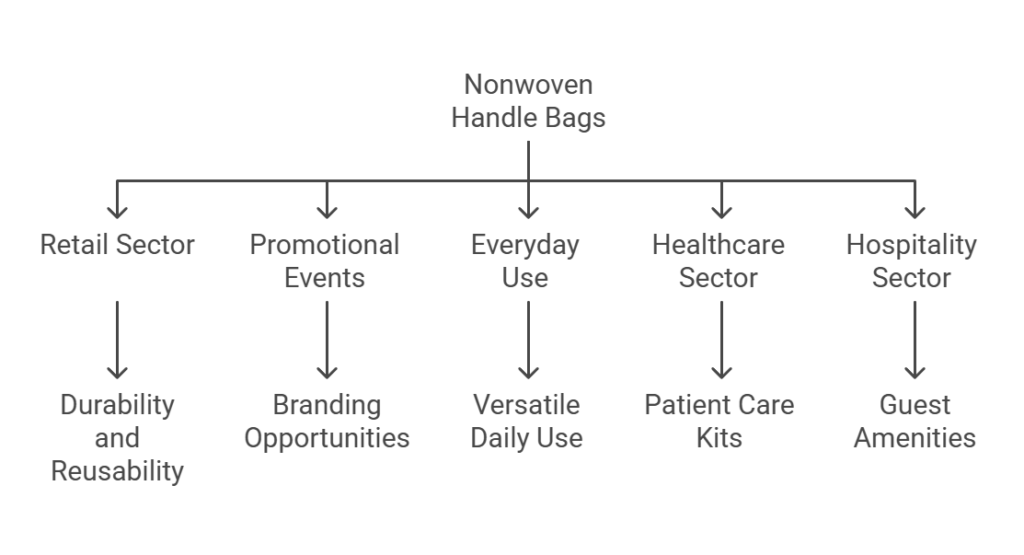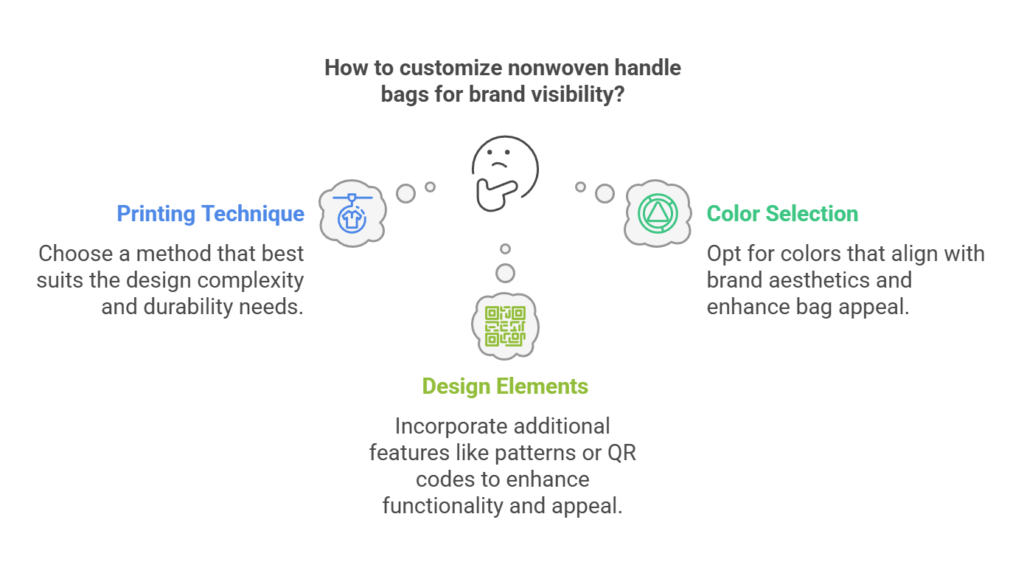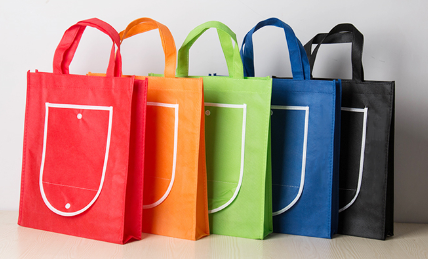Introduction
What are nonwoven handle bags? This seemingly simple question opens the door to a fascinating exploration of a versatile and increasingly popular product. Nonwoven handle bags, often found in retail stores, supermarkets, and promotional events, are made from nonwoven fabric. Unlike traditional woven fabrics, nonwoven materials are produced by bonding fibers together through chemical, mechanical, heat, or solvent treatments. This gives nonwoven handle bags their distinctive durability and lightweight properties.

In the following sections, we will delve deeper into the various aspects of nonwoven handle bags. We’ll discuss their unique manufacturing process, the benefits they offer compared to other types of bags, their environmental impact, and their growing popularity in different sectors. By the end of this blog post, you’ll have a comprehensive understanding of what makes nonwoven handle bags an excellent choice for both consumers and businesses alike.
Answering the Key Question
Nonwoven handle bags are a type of reusable shopping bag made from nonwoven polypropylene fabric. This material is created by bonding polypropylene fibers together using heat and pressure, rather than weaving them. The result is a fabric that is both lightweight and strong, making it ideal for a variety of applications.

The composition of nonwoven handle bags includes polypropylene, a type of plastic polymer known for its durability and flexibility. The nonwoven nature of the fabric provides a smooth surface that can be printed with various designs and logos, making these bags popular for branding and promotional purposes. Additionally, the handles are typically integrated into the bag’s structure, providing a sturdy and convenient carrying solution.
Nonwoven handle bags are primarily used in retail and grocery stores as an eco-friendly alternative to single-use plastic bags. Their durability allows them to carry heavier loads without tearing, making them a reliable choice for consumers. Furthermore, these bags are cost-effective for businesses to produce and distribute, especially when ordered in bulk.
One of the key benefits of nonwoven handle bags is their eco-friendliness. Unlike traditional plastic bags, which can take hundreds of years to decompose, nonwoven polypropylene bags are recyclable and can be reused multiple times before being recycled. This reduces the overall environmental impact and helps in promoting sustainable practices.
In summary, nonwoven handle bags are a practical and environmentally conscious option for both consumers and businesses. Their composition from nonwoven polypropylene fabric ensures they are durable, cost-effective, and eco-friendly, making them an excellent choice for everyday use and promotional purposes.
Materials and Manufacturing Process
Nonwoven handle bags are predominantly made from polypropylene, a versatile and durable polymer. Polypropylene is chosen not only for its strength and flexibility but also for its cost-effectiveness and recyclability. The process of creating nonwoven fabric from polypropylene involves several crucial steps, ensuring the final product is both functional and eco-friendly.

The manufacturing process begins with the polymerization of propylene gas, which produces polypropylene resin. This resin is then melted and extruded to form continuous filaments. These filaments are laid out in a web, creating a sheet of fibers. The nonwoven fabric is formed by bonding these fibers together using heat, chemical, or mechanical methods. Spunbond and meltblown are the most common techniques used in this step, known for producing strong and uniform fabric.
Once the nonwoven fabric is produced, it undergoes a series of treatments to enhance its properties. These treatments might include adding UV stabilizers for outdoor durability or antimicrobial agents for hygiene. The fabric is then cut into the required shapes and sizes, ready to be assembled into bags.
Assembling nonwoven handle bags involves stitching or ultrasonic welding the cut pieces together. Handles, which are usually made from the same nonwoven material, are attached to the bag body, ensuring they can support the weight of the bag’s contents. This step is crucial for providing the bag with its characteristic strength and usability.
An important aspect of the production process is its eco-friendliness. Polypropylene is a recyclable material, and the nonwoven manufacturing process generates minimal waste. Additionally, nonwoven handle bags are reusable, reducing the need for single-use plastic bags and contributing to environmental sustainability. Manufacturers are increasingly adopting green practices, such as using recycled polypropylene and optimizing energy consumption during production, further enhancing the eco-friendly nature of these bags.
Advantages of Nonwoven Handle Bags
Nonwoven handle bags offer a multitude of advantages that make them a preferable choice over other types of bags. Their foremost benefit is reusability. Unlike single-use plastic bags, nonwoven handle bags can be used multiple times, reducing waste and promoting sustainable practices. This reusability factor significantly diminishes the environmental footprint, making them an eco-friendly option.

Another substantial advantage is their biodegradability. Nonwoven handle bags are often made from materials that break down naturally over time, unlike conventional plastic bags that can linger in landfills for hundreds of years. This biodegradability contributes to a healthier environment, reducing the long-term impact on ecosystems.
Strength is a key feature of nonwoven handle bags. They are designed to be robust and can carry heavier loads than traditional plastic or paper bags. This strength makes them ideal for various uses, from grocery shopping to carrying books, ensuring that they do not tear or break easily under pressure.
The versatility of nonwoven handle bags is another noteworthy benefit. They can be customized in numerous ways, including size, color, and design, catering to different needs and preferences. For instance, businesses can brand these bags with their logos and use them as promotional items, while consumers can choose styles that suit their personal tastes.
Nonwoven handle bags are particularly beneficial in several situations. For example, they are excellent for retail environments where customers need durable bags for their purchases. They are also ideal for events and conferences, where attendees can use them to carry informational materials and promotional items. Additionally, their reusable nature makes them perfect for everyday activities such as grocery shopping, gym visits, and picnics.
Overall, the advantages of nonwoven handle bags—reusability, biodegradability, strength, and versatility—make them a superior choice for both businesses and consumers aiming for sustainability and practicality.
Common Uses and Applications
Nonwoven handle bags have become a versatile solution across various industries, owing to their durability, eco-friendliness, and cost-effectiveness. These bags have found significant traction in retail, promotional events, and everyday activities, demonstrating their wide-ranging utility.

In the retail sector, nonwoven handle bags are a popular choice for shoppers. Retailers appreciate their strength and reusability, which make them an excellent alternative to single-use plastic bags. For instance, grocery stores often provide these bags to customers for carrying their purchases, ensuring both convenience and environmental responsibility.
Promotional events are another domain where nonwoven handle bags shine. Companies and organizations frequently use these bags as promotional items, leveraging their ample surface area for branding and advertising. Whether at trade shows, conferences, or corporate giveaways, the bags effectively communicate brand messages and foster customer loyalty. A tech company might, for example, distribute nonwoven handle bags with their logo and slogan at a product launch event, enhancing brand visibility.
In daily activities, nonwoven handle bags prove to be indispensable. They serve various purposes, from carrying gym gear to transporting picnic essentials. Their lightweight nature and sturdy handles make them ideal for everyday use. For example, a student might use a nonwoven handle bag to carry books and supplies, benefiting from its durability and ease of use.
Furthermore, nonwoven handle bags are increasingly being adopted by other sectors such as healthcare and hospitality. Hospitals use them to provide patients with personal care kits, while hotels offer them to guests for carrying toiletries or souvenirs. The adaptability and practicality of these bags make them a preferred choice across diverse applications.
Overall, the widespread use of nonwoven handle bags in various industries underscores their multifaceted advantages. From enhancing customer experiences in retail to providing practical solutions in everyday life, these bags have established themselves as a reliable and eco-friendly option for numerous applications.
Environmental Impact
Nonwoven handle bags have garnered attention for their potential to reduce environmental impact compared to traditional plastic and paper bags. One of the most significant advantages of nonwoven handle bags is their durability, which allows for repeated use. This reusability reduces the need for single-use plastic bags, which are notorious for their contribution to environmental pollution. Unlike plastic bags that can take hundreds of years to decompose, nonwoven bags are made from polypropylene, a material that is more environmentally friendly and can be recycled.

When comparing the ecological footprint of nonwoven handle bags to that of plastic and paper bags, several factors come into play. The production of plastic bags involves the extraction and processing of petroleum, leading to significant carbon emissions. In contrast, nonwoven handle bags, while also derived from polypropylene—a petroleum product—require less energy to produce and generate fewer emissions. Paper bags, while biodegradable, demand high water and energy resources for production, and their frequent use can contribute to deforestation.
Nonwoven handle bags contribute to waste reduction by offering a sustainable alternative to single-use bags. Their strength and longevity mean that they can be used multiple times before needing replacement, thus reducing the volume of waste generated. Additionally, nonwoven bags can be recycled, further minimizing their environmental footprint. Even though the recycling process for polypropylene is not as widespread as for other materials, advancements in recycling technologies are making it increasingly feasible.
Promoting the use of nonwoven handle bags aligns with broader sustainability goals. By encouraging consumers to switch from single-use plastic and paper bags to reusable nonwoven bags, we can foster a culture of environmental responsibility. This shift not only helps in reducing waste but also supports the global effort to mitigate the adverse effects of climate change. As awareness grows and more people adopt nonwoven handle bags, the cumulative positive impact on the environment becomes increasingly significant.
Customization and Design Options
Nonwoven handle bags offer a versatile platform for businesses looking to enhance their brand visibility through personalized designs. These bags can be easily customized with a variety of options, including logos, colors, and unique designs, making them an ideal choice for companies aiming to leave a lasting impression on their customers. The customization process not only adds a personal touch but also serves as a powerful marketing tool, fostering customer loyalty and reinforcing brand identity.

One of the key advantages of nonwoven handle bags is their adaptability to different printing techniques. Businesses can opt for screen printing, digital printing, or heat transfer to imprint their logos and designs. Screen printing is particularly popular for its durability and vibrant color reproduction, while digital printing offers the flexibility of producing detailed and complex images. Heat transfer, on the other hand, is ideal for smaller batches and intricate designs.
Color selection plays a crucial role in the customization of nonwoven handle bags. Companies can choose from a wide spectrum of hues to match their brand’s aesthetic. Whether opting for a minimalist monochrome palette or vibrant, eye-catching colors, the choice of color can significantly influence the bag’s appeal and effectiveness as a promotional item.
In addition to logos and colors, businesses can explore various design elements to make their nonwoven handle bags stand out. This includes adding patterns, slogans, or even QR codes that link to the company’s website or promotional campaigns. The use of eco-friendly inks and materials can further align the bags with the growing consumer demand for sustainable products.
Overall, the customization and design options for nonwoven handle bags are extensive, offering businesses the opportunity to create unique and impactful promotional items. By leveraging these options, companies can enhance their brand visibility, foster customer loyalty, and make a lasting impression in a competitive market.
Frequently Asked Questions (FAQ)
Nonwoven handle bags have become increasingly popular due to their practicality and environmental benefits. Here, we address some common questions to help you better understand these versatile products.
Are nonwoven handle bags durable?
Yes, nonwoven handle bags are known for their durability. They are made from spunbond polypropylene, a material that provides strength and resilience. These bags can withstand significant weight and repeated use without tearing or wearing out, making them an excellent choice for shopping, carrying books, or even daily use.
How much do nonwoven handle bags cost?
The cost of nonwoven handle bags can vary depending on factors such as size, thickness, and customization options. Generally, they are affordable, especially when purchased in bulk. Many businesses find them cost-effective for promotional purposes, as they offer a good balance of durability and cost.
What are the environmental benefits of nonwoven handle bags?
Nonwoven handle bags offer several environmental benefits. Firstly, they are reusable, which significantly reduces the need for single-use plastic bags. This helps to decrease plastic waste and its harmful impact on the environment. Additionally, nonwoven bags are recyclable. Some manufacturers even use recycled materials to produce them, further enhancing their eco-friendly profile.
Can nonwoven handle bags be customized?
Yes, nonwoven handle bags can be easily customized. Businesses often print their logos, slogans, or other designs on these bags to promote their brand. The material takes well to various printing techniques, making it a popular choice for personalized and promotional items.
Are nonwoven handle bags washable?
Nonwoven handle bags are generally washable. They can be cleaned with mild soap and water, which helps to maintain their appearance and hygiene. However, it’s essential to avoid using harsh chemicals or high temperatures, as these can damage the material.
We hope these FAQs have provided you with a clearer understanding of nonwoven handle bags and their numerous benefits. As consumers and businesses increasingly seek sustainable options, these bags stand out as a practical and eco-friendly choice.


2 Responses
I don’t think the title of your article matches the content lol. Just kidding, mainly because I had some doubts after reading the article.
Thank you for your comment! We’re glad you engaged with the article. Could you please share the doubts you had? Your feedback helps us improve.